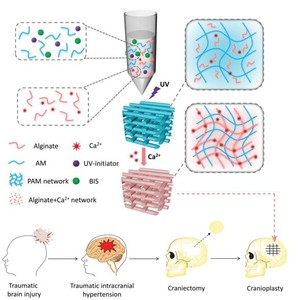A 3D Printable and Bioactive Hydrogel Scaffold to Treat Traumatic Brain Injury
Citation
Lingbin Che#, Zhouyue Lei#, Peiyi Wu*, and Dianwen Song*. A 3D Printable and Bioactive Hydrogel Scaffold to Treat Traumatic Brain Injury. Adv. Funct. Mater. 2019, 29, 1904450.
Abstract
Traumatic brain injury accompanied by intracranial hypertension remains one of the most fatal injuries worldwide. Usually, patients must undergo two surgeries, craniectomy and cranioplasty, to reduce the intracranial pressure and then repair the skull. Traditional biomaterials, such as autologous bones and titanium meshes, which have poor stretchability and very high Young’s modulus values up to hundreds of GPa, tend to constrain intracranial tissue and cannot be implanted directly after craniectomy. Thus far, finding elastic and degradable biomaterials to be immediately implanted after a craniectomy has remained a great challenge, which should not only repair cranial defects but also avoid secondary surgery and reduce the risk of complications, has remained a great challenge. Herein, a 3D printable bioactive hydrogel scaffold with high elasticity that can protect brain tissue, adapt to intracranial pressure changes, allow for the transport of nutrients and the proliferation and osteogenic differentiation of bone mesenchymal stem cells is presented. As indicated by in vivo experiments, the hydrogel scaffold helps to treat traumatic brain injury within 8 weeks and degrades safely. With these advantages, this material shows the potential to open up new horizons for cranioplasty and to help patients survive traumatic brain injury.


